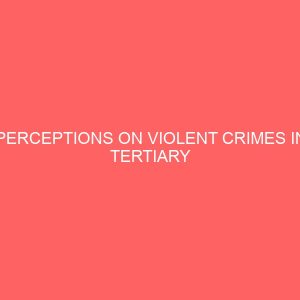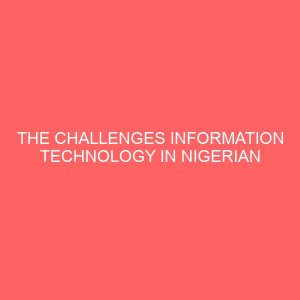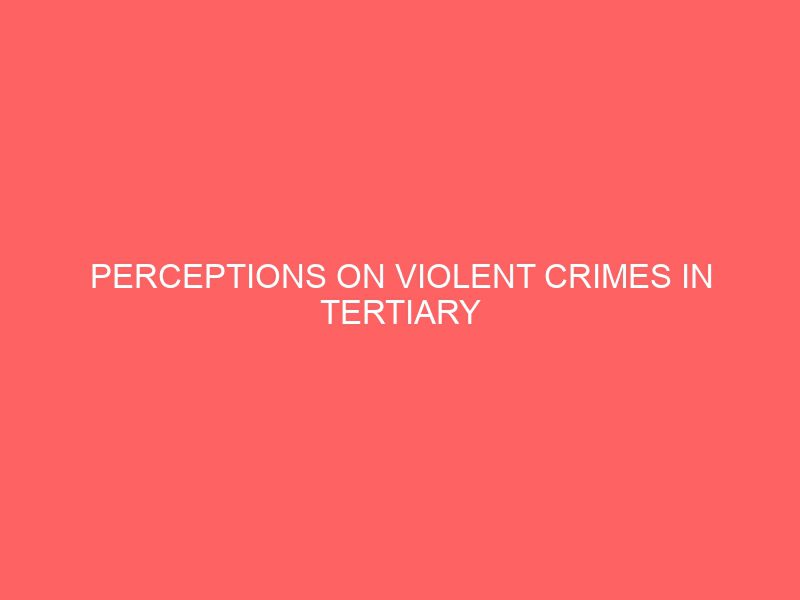Description
CHAPTER ONE INTRODUCTION
1.1 BACKGROUND TO THE STUDY
In the years of Nigerian Political independence, when there were few tertiary institutions in Nigeria, little was known about violent crimes existing in these institutions. Even in the genera! society, the spate of violent criminal activities was iow. Tertiary institutions especially the Universities were truly “citadel of learning”. Those who could not afford to train in these institutions envied undergraduates. Graduates were honoured in the society, and they wasted no time in getting good joes. They were seen as the epitome of knowledge and integrity, partly because they had been educated like the “white-man” and partly because they had been trained in an environment that was less prone to violent crimes, and sc, they did not have criminal tendencies (OdiaKa, 1996:9).
The situat -n in our tertiary institutions today ,s quite different from what it used to be about three or four decades ago. Undergraduates of higher institutions are literally or seemingly besieging their campuses with numerous acts of indiscipline. Their angry shouts of rebellion and violent protests and sometimes destructive actions bear stark witness to the intensity of the growing sense of frustration arid hopelessness.
Violent crimes germinate and thrive in institutions of higher learning in Nigeria. Ezihe (1993:2) noted that Universities and polytechnic campuses in most parts of the country a. a nov/ battlefields where all sorts of violent crimes take place. Such violent criminal acts include robbery, murdar, violent rape, stea.ing, burglary, assault, violent demonstration, assassination, car snatching at gunpoint and the dreaded activities of the cultists Ezike further observed that most of the violent crimes in our tertiary institutions ore basically the handiwork of student cultists.
Nchekwube (1999:17) stated thai violent crimes in tertiary institutions such as homicide, rapes, burglar/, office, home and store- breaking offences are now at alarming proportion. He further said that these violent criminal acts have adverse consequences on the academic and social progress of both the University communities and th -s general society. It is against this background that this study is set to examine the nature and pattern of violent crimes n tertiary institutions in Nigeria with particular reference to the University of Nigeria, Nsukka campus, Vv’ith the view to identifying the causes, and social implications for vhe institution in particular, and the Nigeria society in general.
Department, f )N/F/Pharm/0.6) stated that a lecturer in the Faculty of Pharmaceutical Sciences was shot dead or; 12lh January, 2004 at his fcsidence by unknown person(s). Another circular from the Security Department of the same University (UNN/SEC/15/vol.11: 2004) has it that there have been several reported cases of robbery, rape, duping, car and cell phone snatching on campus. Between 22nd of June and 4th of July, 2004, the University witnessed series of crimes ranging from cell phone snatching, robbery with mask, unlawful possession of fire arms, office breaking and stealing, rape etc. The circular stated that the culprits are students of UNN. The circular also stated that these are just but a few of the reported violent criminal activities on campus. Cases of cell phone snatching, armed robbery and rape, now rank high amongst criminal activities on campus (Security Department, U.N.N., 2004).
Onah, (2003:6) in his own work titled “Varsity students injured as robbers raid female hostel” posits that -he female students of the Cross River State University of Technology (CRUTECH) were injured, and some of them seriously injured when a gang of arnned robbers attacked the female hostel of the Institution. Some of the girls were raped and others assaulted physically. Some weie fractured in Ineir limbs as the robbers invaded the hostel shooting indiscriminately. However, money and property belonging to these girls were carted away while expanded ca-jidges of the robbers were found .’ttehng the buiiding. He further exfi lained tnat .ome of the robbers were late.-‘ discovered to be students of the same Institution.
Omololu, (2005:15) observed that the rate of violent
demonstration in our tertiary institutions is on the increase. In his work
; ,
titled “Violent demonstration in Tertiary Institutions in Nigeria”, Omololu further observed that property worth millions of naira have been destroyed over the years. He however cited the violent demonstration that took place at University of Lagos in April 1998, as well as the Kogi State Polytechnic in June 2002 where students went on violent rampage, burning down the school buildings, including the library. He went further to explain that most of the students involved in the violent acts are cultisto. He also observed thot cuit-members are usually very violent and are involved in ail forms of violent criminal acts within and outside campuses.
Irritated by these criminal acts on campuses, President Olusegun Obasanjo in 1999 directed all universities and other institutions of higher learning to stamp out cultism from their campuses following the death of five students of Obafemi Awolowo University (OAU) lie – Ife, on July 10th 1999. It was against this backdrop that many Institutions
reportedly hac many students renouncing membership of secret cults.
Accordingly, over 300 students of the University of Nigeria, Nsukka (UNN) renounced their membership that same year. Similar cases also occurred at the University of Lagos, Ebonyi State University, Abakaliki, Federal Polytechnic llaro, Ogun State, University of Benin, Ahmadu Bello University, Zaria among others (Okoro, 2003:18).
Nigeria’s Tertiary Institutions therefore appear to be bedeviled by insecurity of Wes and property. Regrettably, this situation has acversely affected the social and academic







